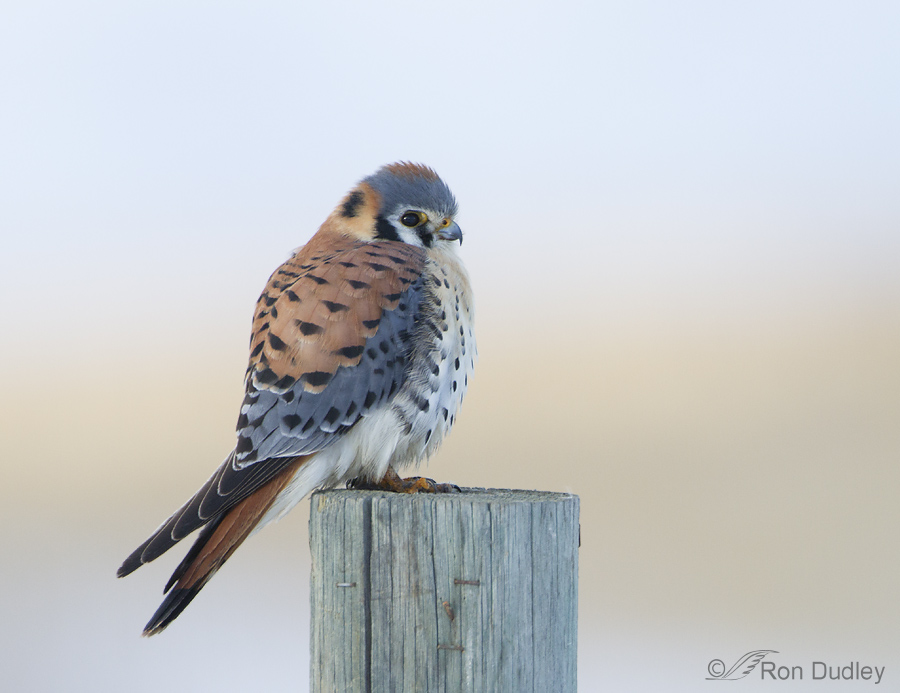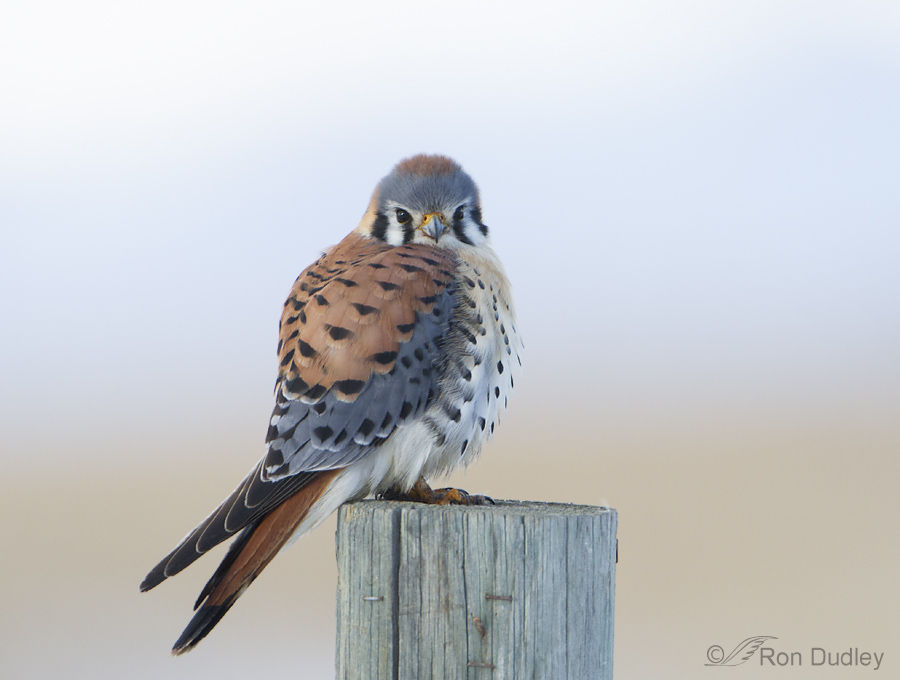I haven’t been able to get close to many male American Kestrels recently but at least I’m seeing a few of them now. They were alarmingly scarce all summer.
1/640, f/6.3, ISO 640, Canon 7D, 500 f/4, 1.4 tc, not baited, set up or called in
I found this one Christmas Eve Day on an old stapled post at Farmington Bay. I was sure he’d fly off as I approached in my pickup because of the noise made by my tires on the snow but this one surprised me by sticking around for a while. There was full sun in the background but semi-shade on the bird so the exposure was a little tricky. I like the pastel colors in the setting.
1/500, f/6.3, ISO 500, Canon 7D, 500 f/4, 1.4 tc, not baited, set up or called in
He didn’t give me many poses but I thought I’d include these two.
In past years the primary prey of this species in my area has been voles and mice but this year I’m seeing them noticeably more often with small birds. This reinforces my unscientific theory (based on a variety of observations) that there’s been a significant crash in the vole population in northern Utah. A few months ago I asked the manager of Antelope Island State Park if he was aware of any recent studies on vole populations and he said “no, but maybe there should be”.
Ron




The pastel setting is lovely and the soft light really flatters him.
Lovely, as always. What a vivid orange cere this little guy has! In the first photo, I’m also drawn to the nice clear view of one of the false eyespots on the back of his head. They don’t always show up as plainly as this one. I imagine you have previously posted other images that show (and describe) both kestrel eyespots together, but that would have been before my visits.
I admit to being obsessed with raptor feet (meaning I always worry about their condition since they’re arguably the most vulnerable part of a raptor… having so little soft tissue and blood supply to aid healing of any lesions). I’m looking at these kestrel images on my phone (which obviously does justice to nothing) and hoping that what look like black patches (and some pale areas?) on his feet don’t suggest frostbite. Hopefully just old remnants of a meal or shedding scutes? Ron, have you seen many birds with frostbitten feet from the vicious cold this season? The diurnals have it so hard with their bare lower legs and toes. If you must live in frigid habitat, hope for feet like a snowy owl….
Maya, you have a practiced eye.
I believe what you’re seeing on your phone is at least partly the effects of shadow though I can also see why you’d be suspicious of foot problems and I could be wrong. This winter hasn’t (yet) been as severe as last year and I didn’t notice (or hear of) frostbitten kestrel(or any raptor species) feet then. Last winter a Barn Owl was rescued near the entrance to the Antelope Island causeway with a “frostbitten face” but after a few days of rehab it was able to be released back into the wild.
Because I respect Jerry Liguori’s comments. (and his blog), when he mentioned a book, I checked it out. I am NOT at all OK ID-ing raptors and have been wondering what to do about it. Because he mentioned Crossley’s raptor ID book, I checked it out on Amazon, and ordered it. It looks like just what I’ve been looking for…pictures of birds flying, what you’d see in the sky, not sitting on a perch. Now I’m wondering what he means by “my books”??????
Patty, Jerry is a renowned raptor authority and the author of several excellent books on the subject. The one I use most often is “Hawks From Every Angle – How To Identify Raptors In Flight”. He’s also a good friend and lots of fun to be with.
OK! Now I know why his name is familiar. I didn’t put the two together…now I’ve got to check out HIS book…maybe THAT’S the one I’ve been looking for )wonder I like to read his comments and like his blog!)
Thanks, Ron…Jerry’s book is also the way via Amazon…I WILL be better at ID-ing raptors in flight and will no longer refer to them all as RTH’s!!!
Thanks Patty!
Yes, I have 2 books of my own and am co-author on the Crossley guide. I love hawks, and Ron ans Mia’s photos of them…just amazing.
My pleasure…can’t wait for them to arrive…another, better Christmas…Will let you know how they work for me…
Good morning, Jerry–I’m getting your raptors book and the Crossley book…what is your other title?
Too bad that handsome little fellow couldn’t afford a blue-gray toupee…the red one he’s wearing doesn’t really match….are they color blind?
Love the contrast between the Kestrel and its background. A beautiful bird, looking remarkably benign. Which it is, unless you are small and it is hungry…
It sounds as if a study of the vole population is overdue. Is there anywhere you can go to suggest that one be undertaken?
Thank you, Elephant’s Child. I’m hoping my question to the gentleman at Antelope Island put a bee in his bonnet but I’m hesitant to push it any further.
Very clever of you to have him pose with a backdrop which features the same coloration as his plumage!
The “cuteness” of these birds belie how tenacious they can be when hunting!
Superb photographs, Ron!
Yup, I’m pretty smart, huh Wally?
I will admit though, that I liked the background colors even through the viewfinder.
Gorgeous, as usual. How wonderful to have a spot like Antelope Island near at hand.
Justine, Actually this shot was taken at Farmington but the island can be good for kestrels also.
Beautiful as always. I totally agree with EllenWascou. 🙂
May I ask you what 1.4tc means?
Thank you Rima and of course you may ask.
“tc” stands for teleconverter. It’s a small optical piece that fits between the lens and the camera that increases magnification. In my case when using my 500mm lens it increases my “reach” from 500mm to 700mm (1.4 x 500).
Whatever your lighting issues were, you seem to have overcome them. These are beautiful shots of a beautiful bird. I am always happy to see photos of Kestrels.
Susan, the lighting on the kestrel was changing every few seconds the entire time I was with the bird. It’s amazing the difference it makes, good and bad. This was one of the shots with the best light but it still wasn’t ideal.
Oh, and did I mention Ron — excellent photos as always.
Thanks, Jerry.
Ellen and Patty’s comments fit perfectly with the INTRO paragraph to “the Crossley ID Guide: Raptors”. I never promote my books, and am not doing that here, its just ironic and fitting, so if anyone has that book, read the Kestrel intro and you will get a laugh.
That’s one of your books that I DON’T have, Jerry. I’ll have to read what it says next time I’m at Barnes and Noble. Or break down and just buy it…
Ha! Jerry – I just read that Kestrel intro this morning – really funny and apt! Love the book – really a different approach.
I released a male kestrel yesterday! He’d come in as an intake after a particularly bad ice storm….seems all the birds were running into stationary objects, but the ones I received have all been released. No broken bones, but mild head trauma that resolved with a few days rest. Beautiful capture, Ron. Beautiful.
Great! One more kestrel flying free. Love knowing that, Leslie.
Round, brown, cute and cuddly-looking,how amazing that these pretty little birds are the tough guys on the block! I hope they make it OK through the winter. So glad you’re seeing them.
I hope they do too, Patty. If conditions don’t get more severe than they have been so far this winter they should do well enough. If they get like they did last year it may be another story…
What a beautiful bird… I’m especially struck by the brilliance of the beak in photo 2. Loved Ellen’s comment about the posing… Certainly this kestrel’s found his Richard Avedon in you! 🙂
Wow – Richard Avedon! That’s certainly a comparison that’s never been made to me before, Alison!
Absolutely beautiful!
Thank you, Patricia.
Just beautiful Ron, thanks for sharing.
Thanks, Dick.
The male AMKE at Leslie poses like this but with the rust color in the sky you have made the little color on his breast stand out. Will check this out on ours when I feed next. Thanks. Never noticed before.
I’m glad this handsome guy helped you to notice it, Diana.
Ron this is perfection … the gentle pastel tones in the background mirror the more dramatic tones of birdie!!!! SO beautiful!!! The complete package!! Well done!!!
Thank you, Lois.
Both of these photos are perfect!! He is ‘Vogueing” for you. First profile. Next the sexy frontal pout!!! Love both of these photos. And since I have never seen this bird ‘live’, I find them totally fascinating. They have a cute, innocent face even though they are killers!! Beautiful!!
I loved your unique “take” on these images, Ellen. Thank you.
Ellen, when you get to see them live, they will become even more intriguing. They are amazing birds, lots of fun to watch. We got to watch a nesting pair and their three offspring last spring, and it was one of the neatest experiences we’ve ever had. I hope you get to see them live.